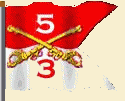February 15 1967 –“OPERATION TUCSON” Black Knights
February 15 1967 –“OPERATION TUCSON” – Bin Long and Tay Ninh Provinces, III Corps - OPCON 3rd Brigade, 1st Infantry Division.
The 1st and 3rd Brigades, 1st Infantry Division conducted a deception operation (prior to the launching of “OPERATION JUNCTION CITY”) along the southeastern edge of War Zone "C" and the northern sector of the Long Nguten secret Zone and the Michelin rubber plantation. In addition to capturing 1,700 tons of rice and 27 tons of salt plus bombs and mines, 13 VC were killed.
Operation Tucson
TUCSON was a 1st Infantry Division operation employing the 1st Brigade under Colonel William B. Caldwell and the 3d Brigade under Colonel Sidney M. Marks. The triangular-shaped area of operations was located in the southwestern corner of Binh Long Province; the town of Minh Thanh was at the north corner, Bau Long on Route 13 at the east corner, and the eastern edge of the Michelin Plantation at the western corner. (Map 10) The terrain is gently rolling with the differences in elevation varying less than forty meters. Cross-country movement is generally good along the edges of the area and along the main roads, Routes 239, 242, and 245. The other areas, moderate to dense jungle, are unsuitable for vehicular traffic and poor for foot traffic.
The area was believed to be an enemy sanctuary containing numerous storage sites and base camps. In addition, it was this area, part of the Long Nguyen secret zone, which contained a portion of the "northern rice route," the major logistical and troop channel between War Zones C and D. Enemy units believed to be operating in the area included elements of the 272d Regiment and the Phu Loi Battalion. Other Viet Cong units included the Ben Cat District (local force) Company and one local force platoon from Chon Thanh. Elements of the Binh Long Province and Chon Thanh District Committees were also thought to be in the area.
The plan called for the 1st Brigade to employ a cavalry squadron to attack south from Minh Thanh along Provincial Routes 13 and 242 to secure a position in the center of the operational area. One battalion of mechanized infantry would sweep southwest from Minh Thanh on Route 245 along the edge of the triangular area, taking up blocking positions in a 15-kilometer arc along Route 245 and in the northeastern portion of the Michelin Plantation. Two battalions of infantry would then attack southwest from Minh Thanh between the positions of the cavalry and mechanized forces and conduct search and destroy operations. On the east, under the control of the division's 3d Brigade, a second cavalry squadron (3d of the 5th Regiment of the U.S. 9th Division) would attack north along Route 13 to Bau Long, then turn to the west for eight kilometers, establish a blocking position, and conduct search and destroy operations. Two infantry battalions would make an airmobile assault into landing zones on the southern edge of the operational area between the 3d of the 5th's blocking position and the eastern corner of the Michelin Plantation. From there they would search and destroy. One infantry battalion would be held at Minh Thanh as a Rapid Reaction Force.
The operation was conducted as planned with only sporadic contact with small elements of the enemy. Although captured documents revealed that the 272d Viet Cong Regiment had recently been in the area, only local guards for the caches and base camps were contacted. The period 14-17 February was used for search and destroy operations during which 1,700 tons of rice and 27 tons of salt were found, almost all uncovered by 3d Brigade elements in caches 50 to 200 meters from the trail along which their initial landing zones were located. (This rice would have fed thirteen enemy battalions for one year.)
The enemy lost 13 killed; U.S. casualties were 3 killed and 65 wounded. A few weapons and some small arms ammunition and explosives were found. About 150 installations were destroyed; among them was a regimental-size base camp with four mess halls and a barbed-wire-enclosed cage dug into the ground which appeared to have been a prisoner of war enclosure large enough for about 30 persons.
It was with great disappointment and reluctance that the search and destroy operations came to a close after only four days, since it was obvious that only a fraction of the rice in the area had been discovered. However, it was necessary for the 1st Division to spend the next four days, 18-21 February, completing the primary mission of TUCSON, positioning its troops and preparing them for JUNCTION CITY.

.gif)


